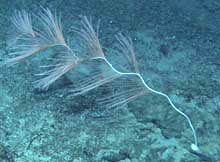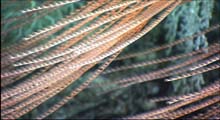
A large (2 m high) specimen of iridogorgia n. sp. from Kelvin seamount. Note how the central stem of the colony is flexible to allow it to bend in the current. Click image for larger view and image credit.
Living in the Flow - Corals
Les Watling
Benthic Ecologist
University of Maine
Most people think of the deep sea as a quiet place where currents are sluggish, which explains why the ocean basins are muddy. However, at intermediate depths (1000 to 3000 m) in the ocean, the water moves at a steady pace, speeding up and slowing down as it encounters various obstacles, or moves through undersea mountain passes.
When deep currents encounter undersea mountains, the effect on the water flow is very similar to what one would experience when climbing a large hill in the wind on land. The water accelerates on the up-current side of the mountain and is slower on the down-current side. Some of the water is deflected over the top of the seamount, but most rushes around the sides. Sometimes circulation cells are set up over the seamount, and these are thought to trap planktonic species or larvae of bottom dwellers in the vicinity of the seamount.
Corals in the deep sea are completely dependent on water flow for their food and to carry their eggs and larvae. Octocorals, being large and sometimes inflexible, may have distinct tolerances to water flow and so some species may not be found in areas where the water is moving too fast. On the other hand, corals cannot feed very efficiently where the flow is too slow. As a result, many octocorals are located on small ridges or promontories where the colony can receive a continuing supply of food particles. So far, on the New England seamounts we have seen that the tallest octocorals, which sometimes reach heights of 4 meters (great than 12 feet) are in areas where there does not appear to be strong water movement.
Close up view of the large Iridogorgia specimen showing the deflection of the polyps and tentacles by the water flowing past the colony. Click image for larger view and image credit.
An octocoral colony is a collection of hundreds of tiny polyps. In some species, the polyps are arranged along all surfaces of the colony. In this case there will be some polyps facing into the current, some side to the current, and some on the down-current side. Because these animals are located in deep ocean environments that we can visit only intermittently, we don't know whether the polyps that seem to be on the down-current side are always down-current, or whether the current oscillates in direction, thus feeding both sides of the colony. It may also be that fan-shaped colonies create eddies on the down-current side, thus bringing food particles into contact with those polyps.
The large spirally-arranged Iridogorgia sp. seems to be ideally suited for feeding in moderately high current velocities. Its spiral shape maximizes the numbers of polyps in the region of flow, and its flexible central axis and branch skeleton allows the colony to bend with the water motion. As the water moves past the colony, all the polyps are arranged in the flow field with their tentacles spread slightly into the current. Exactly how the polyp catches its food particles is still unknown. In 2003 we observed several polyps in close-up for as many as 15 minutes, looking for tentacle "flicking", polyp contraction, or any other indication that something had been caught, but to no avail.

























